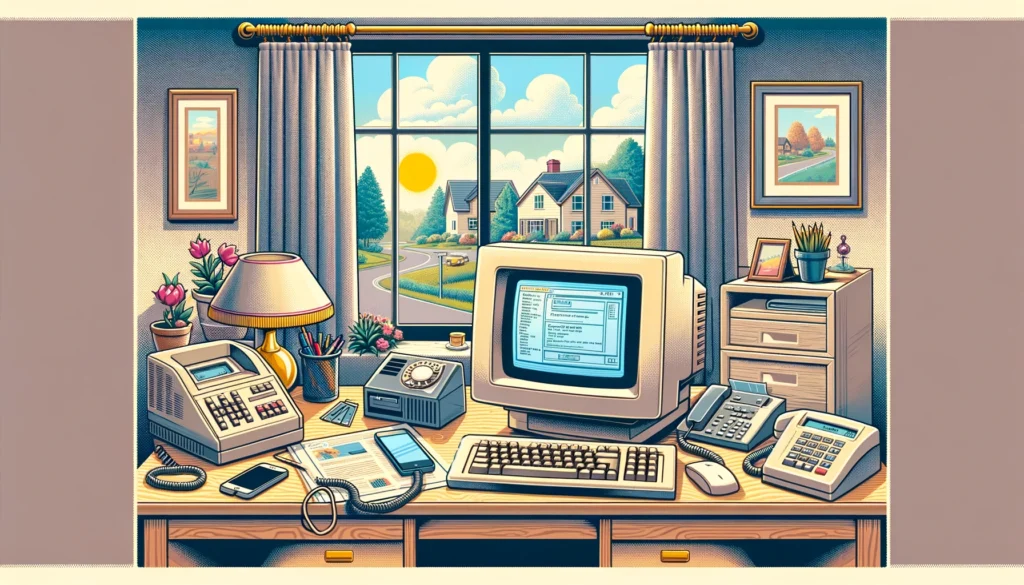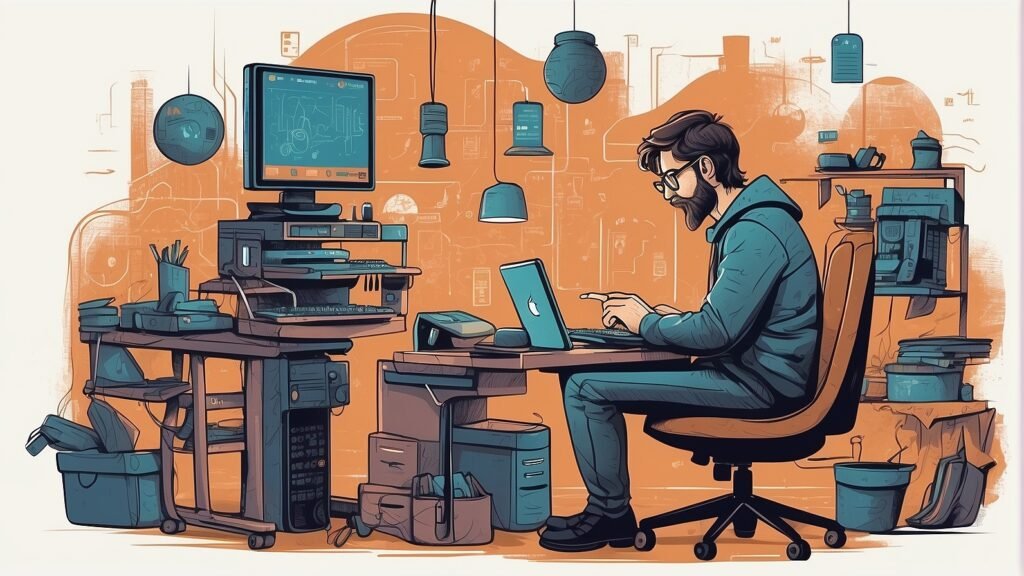Key Takeaways
- Technological advancements enable remote work.
- Historical shifts in the tech industry’s work culture.
- Impact of global events on remote work trends.
- The rise of digital collaboration tools and platforms.
- Challenges and solutions in the remote work ecosystem.

The tech industry has been at the forefront of the remote work revolution, a transformation that reshaped how developers, programmers, and IT professionals engage with their work environments. This evolution didn’t happen overnight; it’s a result of years of technological advancements, cultural shifts, and global events that have collectively redefined the workspace. Let’s dive into the key stages of this evolution.
The Early Days of Remote Work in Tech
Before the internet became ubiquitous, remote work was a rarity, limited to a few freelance programmers or consultants who communicated via email or bulky, slow-loading web pages. The tech industry in the late 20th century was largely office-centric, with collaboration happening in physical spaces filled with whiteboards and server rooms. However, the seeds of remote work were already being planted. Early adopters in the tech world began to experiment with telecommuting, driven by the desire for flexibility and the potential for global collaboration.
The Birth of Digital Communication Tools
The 1990s and early 2000s saw significant strides in digital communication. The advent of faster internet connections and the development of early collaboration tools laid the groundwork for remote work. Email became a standard mode of communication, and the introduction of instant messaging platforms like ICQ and AOL Instant Messenger facilitated quicker, more informal conversations. These tools were crude by today’s standards, but they were revolutionary in breaking down the first barriers to remote work in tech.
The Role of Open Source Communities
Parallel to these technological developments, open-source communities began to thrive. Platforms like SourceForge and later GitHub allowed developers worldwide to collaborate on software projects without ever meeting in person. This culture of distributed work within open-source projects was a precursor to the broader acceptance of remote work in the tech industry. It demonstrated that complex, high-quality software could be developed by remote teams, challenging the traditional office-based work model.

The Rise of Cloud Computing and Virtual Collaboration
The 2000s marked a turning point for remote work, thanks to the explosion of cloud computing. Companies like Google and Microsoft began offering cloud-based productivity suites, making it easier for remote teams to collaborate in real-time. The emergence of cloud storage and virtual office solutions like Google Drive and Microsoft OneDrive revolutionized how documents and projects were managed and shared, setting the stage for a more connected and collaborative remote work environment.
The Impact of Broadband Internet
Broadband internet access was another critical factor. As high-speed internet became more accessible and affordable, it allowed for smoother video conferencing and more efficient online collaboration. Tools like Skype and later Zoom transformed face-to-face meetings, making them virtually accessible and bridging the gap between remote workers and office environments. This period saw a significant uptick in the number of tech companies adopting remote or hybrid work models.
The Growth of Project Management and Collaboration Platforms
During this period, there was also a surge in specialized project management and collaboration platforms. Tools like Asana, Trello, and Slack were developed specifically to cater to the needs of distributed teams. These platforms integrated various aspects of remote work, from task assignment and progress tracking to real-time messaging and file sharing, streamlining the workflow in a way that was previously not possible.
Global Events Catalyzing Remote Work
The tech industry’s shift towards remote work was further accelerated by global events. Economic downturns, for instance, prompted many companies to adopt remote work as a cost-saving measure. But the most significant catalyst came in the form of the COVID-19 pandemic. The global health crisis forced companies worldwide to rapidly adopt remote work to maintain operations while ensuring the safety of their employees.
The Pandemic’s Role in Normalizing Remote Work
The pandemic-era shift to remote work was a trial by fire for many tech companies. It tested the limits of existing remote work technologies and strategies, leading to rapid innovations and adaptations. Companies that had previously resisted remote work paradigms found themselves compelled to embrace them. This period demonstrated the viability of remote work on a scale never seen before, breaking down long-standing prejudices against this mode of operation.
Acceleration of Digital Transformation
The pandemic also accelerated digital transformation initiatives across various industries. Companies invested in cloud infrastructure, cybersecurity, and remote-friendly IT solutions at an unprecedented rate. This investment not only facilitated remote work during the pandemic but also laid the groundwork for a more flexible, remote-friendly future in the tech industry.
Emerging Challenges and Innovative Solutions
As remote work became more prevalent, it brought unique challenges. Issues like maintaining work-life balance, ensuring effective communication, and fostering team cohesion became focal points for remote teams. The tech industry responded with innovative solutions, from AI-driven productivity tools to virtual reality meeting spaces.
Addressing Communication and Collaboration Hurdles
To tackle communication barriers, tech companies started using advanced collaboration tools that offered features like virtual white
boards, integrated task management, and AI-assisted meeting summaries. These tools aimed to replicate the collaborative environment of physical offices, ensuring that remote teams could work together seamlessly.
Ensuring Security and Privacy in Remote Work
The shift to remote work also highlighted the need for robust cybersecurity measures. With employees accessing company networks from various locations, the risk of data breaches and cyberattacks increased. Tech companies responded by strengthening their VPNs, adopting multi-factor authentication, and investing in employee training on cybersecurity best practices.
Promoting Work-Life Balance and Mental Health
Another challenge was maintaining a healthy work-life balance. The blurring of home and work life led to issues like burnout and decreased job satisfaction. Tech companies began to recognize the importance of mental health and work-life balance, implementing policies like flexible work hours, mental health days, and virtual wellness programs. These initiatives aimed to support the wellbeing of remote workers, acknowledging that a healthy work environment is not just about physical space but also about mental and emotional support.

Future Trends in Remote Work Technology
The tech industry continues to innovate, shaping the future of remote work. Emerging technologies like artificial intelligence (AI), machine learning, and the Internet of Things (IoT) are set to revolutionize remote work further. AI-driven analytics can enhance productivity tracking and employee engagement, while IoT devices facilitate seamless remote office setups.
The Role of AI in Streamlining Workflows
AI technologies are increasingly being integrated into remote work tools to automate routine tasks, provide data-driven insights, and facilitate decision-making processes. From smart scheduling assistants to AI-based project management tools, these advancements are making remote work more efficient and less time-consuming.
IoT and the Connected Remote Workplace
IoT technology is transforming the remote work experience by enabling a more connected and interactive workspace. IoT devices can synchronize work environments, adjust lighting and temperature for optimal working conditions, and even monitor health metrics to remind employees to take breaks for well-being.
The Evolution of Virtual and Augmented Reality in Remote Work
Virtual Reality (VR) and Augmented Reality (AR) are poised to be game-changers in the remote work landscape. These technologies offer immersive experiences that can simulate a physical office environment, enabling more interactive and engaging remote meetings and collaborations.
Virtual Offices and Meetings
VR technology can create virtual offices that replicate the experience of being in a physical workspace, complete with meeting rooms and communal spaces. This can significantly enhance the sense of presence and collaboration for remote teams, making interactions more personal and effective.
Training and Development through AR/VR
AR and VR are also being used for training and professional development. These technologies can provide realistic simulations and environments for hands-on training, making it easier for remote employees to acquire new skills or practice complex tasks in a safe, controlled virtual setting.
The Globalization of the Tech Workforce
Remote work has enabled a significant shift towards the globalization of the tech workforce. Companies are no longer limited to hiring talent in their geographical location, opening up opportunities to tap into a global talent pool.
Benefits of a Global Talent Pool
Hiring globally allows companies to access a diverse range of skills and perspectives, fostering innovation and creativity. It also enables operations across different time zones, allowing for around-the-clock productivity and customer support.
Challenges of Managing a Global Team
However, managing a global remote team comes with its challenges, including cultural differences, communication barriers, and coordinating across multiple time zones. Companies are adapting by implementing flexible work policies, investing in cross-cultural training, and utilizing collaboration tools that accommodate diverse work schedules.

The Impact of Remote Work on Urban Development and Sustainability
Remote work is influencing urban development and sustainability. With fewer people commuting to offices, there’s a decrease in traffic congestion and pollution, contributing to environmental sustainability. Additionally, the reduced need for large office spaces is prompting a rethink in urban planning and real estate usage.
Changing Urban Landscapes
Cities are experiencing changes in their commercial real estate markets, with a shift towards mixed-use developments that blend residential, commercial, and recreational spaces. This transformation aligns with the needs of remote workers who seek community and amenities closer to home.
The Role of Remote Work in Sustainable Development
Remote work also aligns with sustainable development goals by reducing carbon emissions from commuting and lowering energy consumption in large office buildings. This shift contributes to a more sustainable future, where work and lifestyle choices are more environmentally friendly.
The Psychological and Social Aspects of Remote Work
The shift to remote work has significant psychological and social implications. While it offers flexibility and autonomy, it can also lead to feelings of isolation and disconnect from colleagues. Companies are exploring ways to address these challenges to maintain employee morale and a sense of community.
Addressing Loneliness and Isolation
To combat loneliness and isolation, companies are creating virtual social events and team-building activities. These initiatives aim to foster a sense of community and belonging among remote workers, which is crucial for maintaining a healthy and productive workforce.
The Importance of Mental Health Support
Recognizing the mental health challenges associated with remote work, companies are increasingly offering support services like counseling and stress management programs. Creating a culture that prioritizes mental health is essential for the wellbeing of remote employees and the overall success of remote work models.
Balancing Productivity and Surveillance in Remote Work
The rise of remote work has brought to the forefront the delicate balance between employee productivity and privacy. Companies are exploring various tools and methods to ensure productivity without infringing on employee privacy.
Productivity Tracking Tools
Advanced software solutions are being used to track employee productivity, measuring metrics like active work hours, project progress, and task completion. While these tools provide valuable data, there’s an ongoing debate about the extent of monitoring and its impact on employee trust and autonomy.
Ethical Considerations of Employee Surveillance
Ethical considerations are critical when implementing productivity tracking tools. Companies must strike a balance between gathering necessary data and respecting employee privacy. Clear communication about the use of these tools and adherence to privacy laws are essential in maintaining a healthy work environment.
The Integration of AI and Machine Learning in Remote Work
Artificial Intelligence (AI) and Machine Learning (ML) are increasingly being integrated into remote work environments, offering new ways to enhance productivity and decision-making.
AI-Driven Efficiency
AI-driven tools can automate routine tasks, organize workflows, and provide predictive analytics, helping remote teams work more efficiently. These tools can also personalize employee experiences, suggesting breaks or tasks based on individual work patterns.
Machine Learning for Improved Collaboration
ML algorithms are being used to improve team collaboration by analyzing communication patterns and providing insights for more effective team dynamics. This includes optimizing meeting schedules, managing project timelines, and identifying areas for improved collaboration.
The Role of Gig Economy in Remote Tech Work
The gig economy has become an integral part of the remote work landscape, especially in the tech industry. Freelancers and contract workers are increasingly common, providing flexibility for both employees and employers.
Advantages of Freelance and Contract Work
For many tech professionals, freelance or contract work offers the ultimate flexibility and control over their careers. Companies benefit from this arrangement by having access to specialized skills on-demand, without the long-term commitment of a full-time hire.
Challenges and Solutions for Gig Workers
However, gig work also presents challenges such as job insecurity and lack of benefits. The tech industry is responding with platforms and communities that offer support to freelancers, including networking opportunities, professional development resources, and access to health and financial benefits.
The Future of Office Spaces in a Remote-First Tech World
As remote work becomes more prevalent, the concept of the office is evolving. Tech companies are rethinking their physical office spaces to accommodate the needs of a remote-first workforce.
Hybrid Work Environments
Many companies are adopting hybrid models, where employees have the option to work from home or come into the office. This approach requires reconfiguring office spaces to be more collaborative and flexible, supporting both in-person and remote work.
The Decline of Traditional Office Spaces
Traditional office spaces with cubicles and fixed desks are giving way to more dynamic setups. These include co-working spaces, meeting hubs, and areas for social interaction, reflecting the changing nature of work in the tech industry.

Enhancing Remote Work with Smart Home Integration
The intersection of remote work and smart home technology is creating more efficient and comfortable home office environments. Tech advancements are enabling better integration of work and home life.
Smart Home Devices for Productivity
Smart home devices like intelligent lighting, voice-activated assistants, and ergonomic furniture are being designed to enhance productivity and comfort. These technologies allow remote workers to create personalized work environments that adapt to their needs.
Work-Life Balance with Smart Home Integration
Integrating smart home technology also helps in maintaining a work-life balance. Automated reminders for breaks, exercise, and work hours help remote workers manage their time more effectively, reducing the risk of burnout.
Conclusion
The evolution of remote work in the tech industry reflects a remarkable journey of innovation, adaptability, and resilience. From the early days of digital communication to the current era of AI and smart home integration, the way tech professionals engage with their work has fundamentally changed. This evolution not only reshapes the tech industry but also sets a precedent for the global workforce. The future of remote work in tech promises further advancements, challenges, and opportunities, as companies continue to navigate this dynamic landscape. Embracing these changes while maintaining a focus on productivity, privacy, and employee well-being will be key to harnessing the full potential of remote work.
Table: Key Milestones in the Evolution of Remote Work in Tech
| Era | Key Developments | Impact on Remote Work | Future Implications |
|---|---|---|---|
| Late 20th Century | Birth of Digital Communication | Foundation for remote collaboration | Paved the way for modern remote work tools |
| Early 2000s | Rise of Cloud Computing | Enhanced real-time collaboration | Set the stage for cloud-based work environments |
| Mid-2000s | Broadband Internet Access | Enabled smoother video conferencing | Facilitated global connectivity and collaboration |
| 2010s | Global Events (e.g., COVID-19) | Accelerated remote work adoption | Highlighted the viability and challenges of remote work |
| Present | AI and Smart Home Tech | Streamlining and personalizing remote work | Shaping the future of integrated work-life environments |
Frequently Asked Questions
How Has Technology Specifically Influenced Remote Work in the Tech Industry?
Technology has been a driving force in the evolution of remote work, providing tools and platforms that enable seamless communication, collaboration, and productivity. Developments like broadband internet, cloud computing, and AI have revolutionized the way tech professionals work remotely, making it more efficient and accessible.
What Are the Main Challenges of Remote Work in the Tech Industry?
Key challenges include maintaining effective communication, ensuring cybersecurity, balancing productivity with privacy, and promoting a healthy work-life balance. Addressing these challenges requires a combination of innovative technology solutions and thoughtful management practices.
How Do AI and Machine Learning Contribute to Remote Work?
AI and machine learning contribute by automating routine tasks, optimizing workflows, and providing data-driven insights for better decision-making. They help in personalizing the remote work experience and improving team collaboration.
What Is the Role of the Gig Economy in Remote Tech Work?
The gig economy allows for flexibility and control for both workers and employers in the tech industry. It provides access to a global talent pool and specialized skills on-demand, but also presents challenges like job insecurity and lack of benefits.
How Are Office Spaces Evolving in a Remote-First Tech World?
Office spaces are evolving to accommodate hybrid work models, with more collaborative and flexible designs. Traditional office setups are giving way to co-working spaces and meeting hubs that support both in-person and remote work.
What Is the Impact of Remote Work on Urban Development and Sustainability?
Remote work is contributing to less traffic congestion, reduced pollution, and a decreased need for large office spaces. This is leading to more sustainable urban planning and development, with a focus on mixed-use spaces that cater to remote workers’ needs.

How Can Companies Balance Productivity Tracking with Employee Privacy?
Companies can balance this by using productivity tracking tools ethically and transparently. They should communicate clearly about the use of these tools, adhere to privacy laws, and ensure that monitoring does not infringe on employee autonomy and trust.
How Does Smart Home Integration Enhance Remote Work?
Smart home integration enhances remote work by creating efficient and comfortable home office environments. Smart devices like intelligent lighting, ergonomic furniture, and voice-activated assistants help create personalized workspaces that boost productivity and comfort.
This comprehensive overview and FAQs provide a deep understanding of the evolution of remote work in the tech industry, highlighting key developments, challenges, and future trends. As remote work continues to evolve, staying informed and adaptable will be essential for both companies and employees in the tech sector.